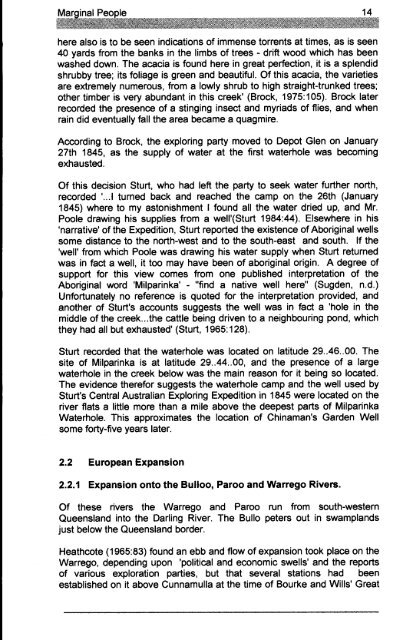Adec Preview Generated PDF File - The Sydney eScholarship ...
Adec Preview Generated PDF File - The Sydney eScholarship ...
Adec Preview Generated PDF File - The Sydney eScholarship ...
You also want an ePaper? Increase the reach of your titles
YUMPU automatically turns print PDFs into web optimized ePapers that Google loves.
here also is to be seen indications of immense torrents at times, as is seen<br />
40 yards from the banks in the limbs of trees - drift wood which has been<br />
washed down. <strong>The</strong> acacia is found here in great perfection, it is a splendid<br />
shrubby tree; its foliage is green and beautiful. Of this acacia, the varieties<br />
are extremely numerous, from a lowly shrub to high straight-trunked trees;<br />
other timber is very abundant in this creek' (Brock, 1975: 105). Brock later<br />
recorded the presence of a stinging insect and myriads of flies, and when<br />
rain did eventually fall the area became a quagmire.<br />
According to Brock, the exploring party moved to Depot Glen on January<br />
27th 1845, as the supply of water at the first waterhole was becoming<br />
exhausted.<br />
Of this decision Sturt, who had left the party to seek water further north,<br />
recorded '...1 turned back and reached the camp on the 26th (January<br />
1845) where to my astonishment I found all the water dried up, and Mr.<br />
Poole drawing his supplies from a well'(Sturt 1984:44). Elsewhere in his<br />
'narrative' of the Expedition, Sturt reported the existence of Aboriginal wells<br />
some distance to the north-west and to the south-east and south. If the<br />
'well' from which Poole was drawing his water supply when Sturt returned<br />
was in fact a well, it too may have been of aboriginal origin. A degree of<br />
support for this view comes from one published interpretation of the<br />
Aboriginal word 'Milparinka' - "find a native well here" (Sugden, n.d.)<br />
Unfortunately no reference is quoted for the interpretation provided, and<br />
another of Sturt's accounts suggests the well was in fact a 'hole in the<br />
middle of the creek...the cattle being driven to a neighbouring pond, which<br />
they had all but exhausted' (Sturt, 1965: 128).<br />
Sturt recorded that the waterhole was located on latitude 29..46..00. <strong>The</strong><br />
site of Milparinka is at latitude 29..44..00, and the presence of a large<br />
waterhole in the creek below was the main reason for it being so located.<br />
<strong>The</strong> evidence therefor suggests the waterhole camp and the well used by<br />
Sturt's Central Australian Exploring Expedition in 1845 were located on the<br />
river flats a little more than a mile above the deepest parts of Milparinka<br />
Waterhole. This approximates the location of Chinaman's Garden Well<br />
some forty-five years later.<br />
2.2 European Expansion<br />
2.2.1 Expansion onto the Bulloo, Paroo and Warrego Rivers.<br />
Of these rivers the Warrego and Paroo run from south-western<br />
Queensland into the Darling River. <strong>The</strong> Bullo peters out in swamplands<br />
just below the Queensland border.<br />
Heathcote (1965:83) found an ebb and flow of expansion took place on the<br />
Warrego, depending upon 'political and economic swells' and the reports<br />
of various exploration parties, but that several stations had been<br />
established on it above Cunnamulla at the time of Bourke and Wills' Great




